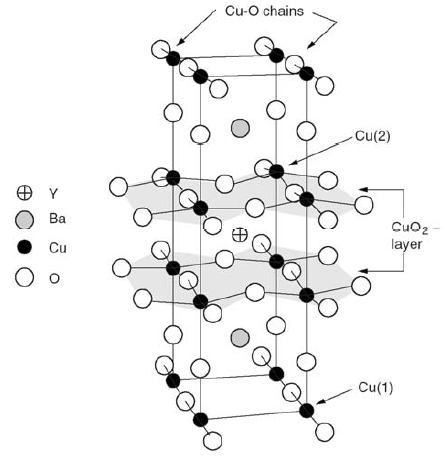SKEDSOFT
High – Tc superconductors: becomes a superconductor at room temperature. A discovery of this type will revolutionize every aspect of modern day technology such as power transmission and storage, communication, transport and even the type of computers we make. All of these advances will be faster, cheaper and more energy efficient. This has not been achieved to date. However, in 1986 a class of materials was discovered by Bednorz and Müller that led to superconductors that we use today on a bench-top with liquid nitrogen to cool them. Not surprisingly, Bednorz and Müller received the Nobel Prize in 1987 (the fastest-ever recognition by the Nobel committee). The material we mostly use on bench-tops is Yttrium – Barium – Copper Oxide, or YBa2Cu3O7, otherwise known as the 1-2-3 superconductor, and are classified as high temperature (Tc) superconductors.
The critical temperature of some high-Tc superconductors is given in Figure 1. Critical temperatures as high as 135 K have been achieved. Whilst this is not room temperature, it has made experiments on superconductivity accessible to more people since these need only be cooled by liquid nitrogen (with a
boiling point of liquid nitrogen is 77 K), which is cheap and readily available. This is in contrast to the expensive and bulky equipment that used liquid helium for cooling the traditional types of superconductors. Moreover, the superconductors are calculated to have an upper critical magnetic field, Bc2, of about 200 Tesla – huge!
The crystal lattice structure of YBa2Cu3O7 is shown in Figure 1. Unlike traditional superconductors, conduction mostly occurs in the planes containing the copper oxide. It has been found that the critical temperature is very sensitive to the average number of oxygen atoms present, which can vary. For this reason the formula for 1-2-3 superconductor is sometimes given as YBa2Cu3O7-δ where δ is a number between 0 and 1.
The nominal distance between cooper pairs (coherence length) in these superconductors can be as short as one or two atomic spacings. As a result, the coulomb repulsion force will generally dominate at these distances causing electrons to be repelled rather than coupled. For this reason, it is widely accepted that Cooper pairs, in these materials, are not caused by a lattice deformation, but may be associated with the type of magnetism present (known as antiferromagnetism) in the copper oxide layers. So high–Tc superconductors cannot be explained by the BCS theory since that mainly deals with a lattice deformation mediating the coupling of electron pairs. The research continues into the actual mechanism responsible for superconductivity in these materials.

Figure 1. Crystal lattice structure of the High – Tc superconductor, YBa2Cu3O7.